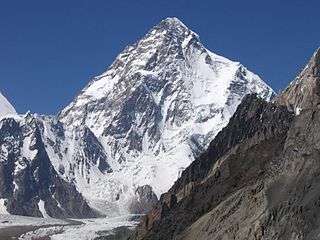Reinhold Messner
|
Reinhold Messner (2015) | |
| Personal information | |
|---|---|
| Nationality | Italian |
| Born |
17 September 1944 Brixen (Bressanone), Italy |
| Website | www.reinhold-messner.de |
| Climbing career | |
| Known for | First to climb all 14 eight-thousanders |
| First ascents |
|
| Major ascents | Mount Everest first solo ascent without supplemental oxygen |
Reinhold Messner (German pronunciation: [ˈʁaɪ̯nhɔlt ˈmɛsnɐ]; born 17 September 1944) is an Italian mountaineer, adventurer, explorer, and author from the autonomous Italian province of South Tyrol.
He made the first ascent of Mount Everest without supplemental oxygen, along with Peter Habeler, and was the first climber to ascend all fourteen peaks over 8,000 metres (26,000 ft) above sea level, including Mount Everest. Messner also writes books about alpinism.
Biography
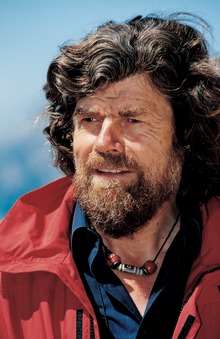
Born in Brixen (Bressanone), Italy, Messner is an Italian citizen whose mother tongue is German. He is also fluent in Italian and English.[1] He grew up in Villnöß and spent his early years climbing in the Alps and fell in love with the Dolomites. His father, Josef Messner, was a teacher. He was also very strict and sometimes severe with Reinhold. Josef led Reinhold to his first summit at the age of five. Reinhold had eight brothers and one sister; he later climbed with his brother Günther and made Arctic crossings with his brother Hubert.
When Reinhold was 13, he began climbing with his brother Günther, age 11. By the time Reinhold and Günther were in their early twenties, they were among Europe's best climbers.[2]
Since the 1960s, Messner, inspired by Hermann Buhl, was one of the first and most enthusiastic supporters of alpine style mountaineering in the Himalayas, which consisted of climbing with very light equipment and a minimum of external help. Messner considered the usual expedition style ("siege tactics") disrespectful toward nature and mountains.
Messner's first major Himalayan climb in 1970, the unclimbed Rupal face of Nanga Parbat, turned out to be a tragic success. Both he and his brother Günther reached the summit, but Günther died two days later on the descent of the Diamir face. Reinhold lost seven toes, which had become badly frostbitten during the climb and required amputation.[2] Reinhold was severely criticized for persisting on this climb with the less experienced Günther.[3] The 2010 movie Nanga Parbat by Joseph Vilsmaier is based on his account of the events.[4]
While Messner and Peter Habeler were noted for fast ascents in the Alps of the Eiger North Wall, standard route (10 hours) and Les Droites (8 hours), his 1975 Gasherbrum I first ascent of a new route took three days. This was unheard of at the time.
In the 1970s, Messner championed the cause for ascending Mount Everest without supplementary oxygen, saying that he would do it "by fair means" or not at all.[5] In 1978, he reached the summit of Everest with Habeler.[5] This was the first time anyone had been that high without bottled oxygen and Messner and Habeler proved what certain doctors, specialists, and mountaineers thought impossible. He repeated the feat, without Habeler, from the Tibetan side in 1980, during the monsoon season. This was Everest's first solo summit.
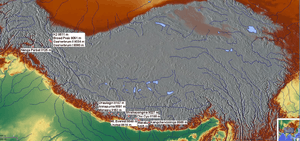
In 1978, he made a solo ascent of the Diamir face of Nanga Parbat. In 1986, Messner became the first to complete all fourteen eight-thousanders (peaks over 8,000 metres above sea level).[6] Messner has crossed Antarctica on skis, together with fellow explorer Arved Fuchs. He has written over 60 books[7] about his experiences, a quarter of which have been translated. He was featured in the 1984 film The Dark Glow of the Mountains by Werner Herzog.
Messner today carries on a diversified business related to his mountaineering skills. From 1999 to 2004, he held political office as a Member of the European Parliament for the Italian Green Party (Federazione dei Verdi). He was also among the founders of Mountain Wilderness, an international NGO dedicated to the protection of mountains worldwide.
In 2004 he completed a 2,000-kilometre (1,200 mi) expedition through the Gobi desert. He now mainly devotes himself to the Messner Mountain Museum, of which he is the founder.
Expeditions
To 1970
Up to 1970, Reinhold Messner had made a name for himself mainly through his achievements in the Alps. Between 1960 and 1964, he led over 500 ascents, most of them in the Dolomites. In 1965, he climbed a new direttissima route on the north face of the Ortler. A year later, he climbed the Walker Spur on the Grandes Jorasses and ascended the Rocchetta Alta di Bosconero. In 1967 he made the first ascent of the northeast face of the Agnér and the first winter ascents of the Agnér north face and Furchetta north face.
In 1968 he achieved further firsts: the Heiligkreuzkofel middle pillar and the direct south face of the Marmolada. In the following year, Messner joined an Andes expedition, during which he succeeded, together with Peter Habeler, in making the first ascent of the Yerupaja east face up to the summit ridge and, a few days later, the first ascent of the 6,121-metre-high Yerupaja Chico[8] He also made the first solo ascent of the Droites north face, the Philipp-Flamm intersection on the Civetta and the south face of Marmolata di Rocca. As a result of his achievements, Messner won the reputation of being one of the best climbers in Europe. So, in 1970, he was invited to join a major Himalayan expedition. In the light of his later successes, the year 1970 can be regarded as one of the turning points in Messner's life.
Climbs of the eight-thousanders after 1970
Reinhold Messner was the first man to climb all fourteen eight-thousanders in the world and without supplemental oxygen. His climbs were also all amongst the first 20 ascents for each mountain individually. Specifically, these are:
| Year | Peak (height in metres) | Remarks |
|---|---|---|
| 1970 | Nanga Parbat (8,125) | |
| 1972 | Manaslu (8,163) | |
| 1975 | Hidden Peak (Gasherbrum I) (8,080) | |
| 1978 | Mount Everest (8,848), Nanga Parbat (8,125) | First ascent of Everest without supplementary oxygen. Nanga Parbat: first solo ascent of 8000er from basecamp |
| 1979 | K2 (8,611) | |
| 1980 | Mount Everest (8,848) | First to ascend alone and without supplementary oxygen – during the monsoon |
| 1981 | Shishapangma (8,027) | |
| 1982 | Kangchenjunga (8,586), Gasherbrum II (8,034), Broad Peak (8,051) | Also a failed summit attempt on Cho Oyu during winter |
| 1983 | Cho Oyu (8,188) | |
| 1984 | Hidden Peak (Gasherbrum I) (8,080), Gasherbrum II (8,034) | All achieved at one time without returning to basecamp |
| 1985 | Annapurna (8,091), Dhaulagiri (8,167) | |
| 1986 | Makalu (8,485), Lhotse (8,516) |
Nanga Parbat
Reinhold Messner took a total of five expeditions to Nanga Parbat. In 1970 and 1978 he reached the summit; in 1971, 1973 and 1977, he did not. In 1971 he was primarily looking for his brother's remains.
Rupal Face 1970
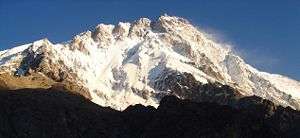
In May and June 1970, Reinhold Messner took part in the Nanga Parbat South Face expedition led by Karl Herrligkoffer, the objective of which was to climb the as yet unclimbed Rupal Face, the highest rock and ice face in the world. Messner's brother, Günther, was also a member of the team. On the morning of 27 June, Messner was of the view that the weather would deteriorate rapidly, and set off alone from the last high-altitude camp. Surprisingly his brother climbed after him and caught up to him before the summit. By late afternoon, both had reached the summit of the mountain and had to pitch an emergency bivouac shelter without tent, sleeping bags and stoves because darkness was closing in.
The events that followed have been the subject of years of legal actions and disputes between former expedition members, and have still not been finally resolved. What is known now is that Reinhold and Günther Messner descended the Diamir Face, thereby achieving the first crossing of Nanga Parbat (and second crossing of an eight-thousander after Mount Everest in 1963). Reinhold arrived in the valley six days later with severe frostbite, but survived. His brother, Günther, however died on the Diamir Face—according to Reinhold Messner on the same descent, during which they became further and further separated from each other. As a result, the time, place and exact cause of death is unknown. Messner claimed his brother had been swept away by an avalanche.
In the early years immediately after the expedition, there were disputes and lawsuits between Messner and the expedition leader, Karl-Maria Herrligkoffer. After a quarter-century of peace, the dispute flared up again in October 2001, when Messner raised surprising allegations against the other members of the team for failing to come to their aid. The rest of the team consistently maintained that Reinhold Messner had told them of his idea for crossing the mountain before setting off for the summit. Messner himself asserts, however, that he made a spontaneous decision to descend the Diamir Face together with his brother for reasons of safety. A number of new books—by Max von Kienlin, Hans Saler, Ralf-Peter Märtin, and Reinhold Messner—stoked the dispute (with assumptions and personal attacks) and led to further court proceedings.
In June 2005, after an unusual heat wave on the mountain, the body of his brother was recovered on the Diamir Face, which seems to support Messner's account of how Günther died.[9][10]
The drama was turned into a film Nanga Parbat (2010) by Joseph Vilsmaier, based on the memories of Reinhold Messner and without participation from the other former members of the expedition. Released in January 2010 in cinemas, the film was criticized by the other members of the team for telling only one side of the story.[10]
Because of severe frostbite, especially on his feet—six toes were amputated—Messner was not able to climb quite as well on rock after the 1970 expedition. He therefore turned his attention to higher mountains, where there was much more ice.[11]
Solo climb in 1978
After three unsuccessful expeditions, Reinhold Messner reached the summit of Nanga Parbat again via the Diamir Face on 9 August 1978.
Manaslu
In 1972, Messner succeeded in climbing Manaslu on what was then the totally unknown south face of the mountain, of which there were not even any pictures. From the last high-altitude camp he climbed with Frank Jäger, who turned back before reaching the summit. Shortly after Messner reached the summit, the weather changed and heavy fog and snow descended. Initially Messner became lost on the way down, but later found his way back to the camp, where Horst Fankhauser and Andi Schlick were waiting for him and Jäger. Jäger did not return, although his cries were heard from the camp. Orientation had become too difficult. Fankhauser and Schlick began to search for him that evening, but lost their way and sought shelter at first in a snow cave. Messner himself was no longer in a position to help the search. The following day, only Horst Fankhauser returned. Andi Schlick had left the snow cave during the night and become lost. So the expedition had to mourn the loss of two climbers. Messner was later criticised for having let Franz Jäger go back down the mountain alone.[11]
Gasherbrum I
The ascent of Gasherbrum I saw for the first time a mountaineering expedition succeeding in scaling an eight-thousander using alpine style climbing. Until that point, all fourteen 8000-meter peaks had been summitted using the expedition style, though Hermann Buhl had earlier advocated "West Alpine Style" (similar to "capsule" style, with a smaller group relying on minimal fixed ropes). Together with Peter Habeler, Messner succeeded in making the second ascent of Gasherbrum I on 10 August 1975, becoming the first man ever to climb three eight-thousanders.
Messner reached the summit again in 1984, this time together with Hans Kammerlander. This was achieved as part of a double ascent where, for the first time, two eight-thousander peaks (Gasherbrum I and II) were climbed without returning to base camp. Again, this was done in alpine style, i.e. without the pre-location of stores.[11]
Mount Everest
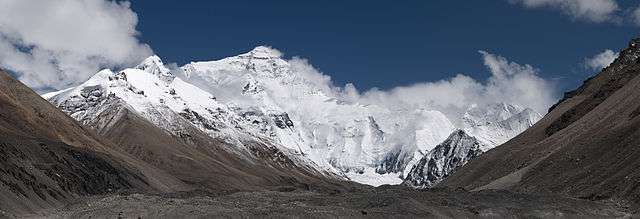
On 8 May 1978, Reinhold Messner stood with Peter Habeler on the summit of Mount Everest; the first men known to climb Everest without the use of supplemental oxygen. Prior to this ascent it was disputed whether this was possible at all. Messner and Habeler were members of an expedition led by Wolfgang Nairz along the southeast ridge to the summit. Also on this expedition was Reinhard Karl, the first German to reach the summit (with oxygen).
Two years later, on 20 August 1980, Messner again stood atop the highest mountain in the world. This time, too, the ascent was made without supplementary oxygen. For this solo climb, he chose the northeast ridge to the summit, where he crossed above the North Col in the North Face to the Norton Couloir and became the first man to climb through this steep gorge to the summit. Messner decided spontaneously during the ascent to use this route to bypass the exposed northeast ridge. Prior to this solo ascent, he had not set up a camp on the mountain.[11]
K2
For 1979, Messner was planning to climb K2 on a new direct route through the South Face, which he called the "Magic Line". Headed by Messner, the small expedition consisted of six climbers: Italians Alessandro Gogna, Friedl Mutschlechner and Renato Casarotto; the Austrian, Robert Schauer; and Germans Michael Dacher, journalist, Jochen Hölzgen, and doctor Ursula Grether, who was injured during the approach and had to be carried to Askole by Messner and Mutschlechner. Because of avalanche danger on the original route and time lost on the approach, they decided on climbing via the Abruzzi Spur. The route was equipped with fixed ropes and high-altitude camps, but no hauling equipment (Hochträger) or bottled oxygen was used. On 12 July, Messner and Dacher reached the summit; then the weather deteriorated and attempts by other members of the party failed.[12][13]
Shishapangma
During his stay in Tibet as part of his Everest solo attempt, Messner had the opportunity to explore Shishapangma. A year later, Messner, with Friedel Mutschlechner, Oswald Oelz and Gerd Baur, set base camp on the north side of the only eight-thousander which is entirely within Chinese territory. On 28 May, Messner and Mutschlechner reached the summit in very bad weather; part of the climb involving ski mountaineering.[11][13][14]
Kangchenjunga
In 1982, Messner wanted to become the first climber ever to scale three eight-thousanders in one year. He was planning on climbing Kangchenjunga first, before tackling Gasherbrum II and the Broad Peak.
Messner had chosen a new variation of the route up the North Face. Because there was still a lot of snow at the time of the expedition, Messner and Mutschlechner made very slow progress. In addition, the sheer difficulty of the climb forced the two mountaineers to use fixed ropes. Finally, on 6 May, Messner, Mutschlechner and Ang Dorje stood on the summit. There, Mutschlechner suffered frostbite to his hands, and later to his feet as well. Whilst bivouacking during the descent, the tent tore away from Mutschlechner and Messner, and Messner also fell ill. He was suffering from an amoebic abscess in the liver, making him very weak. In the end he only made it back to base camp with Mutschlechner's help.[11]
Gasherbrum II
After his ascent of Kangchenjunga, Mutschlechner flew back to Europe because his frostbite had to be treated and Messner needed rest. Thus the three mountains could not be climbed as planned. Messner was cured of his amoebic abscess in the liver and then travelled to Gasherbrum II, but could not use the new routes as planned. In any case, his climbing partners, Sher Khan and Nazir Sabir, would not have been strong enough. Nevertheless, all three reached the summit on 24 July in a storm. During the ascent, Messner discovered the body of a previously missing Austrian mountaineer, whom he buried two years later at the G I – G II crossing.[11]
Broad Peak
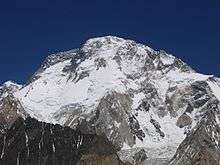
Broad Peak was the third eight-thousander scaled by Messner in 1982. At the time, he was the only person with a permit to climb this mountain, but he came across Jerzy Kukuczka and Wojciech Kurtyka, who had permits to climb K2, but used its geographic proximity to climb Broad Peak illegally. In early descriptions of the ascent, Messner omitted to mention this encounter, but he referred to it several years later. On 2 August, Messner was reunited with Nazir Sabir and Khan again on the summit. The three mountaineers had decamped and made for Broad Peak immediately after their ascent of Gasherbrum II. The climb was carried out with a variation from the normal route at the start.[11]
Cho Oyu
In the winter of 1982/1983, Messner attempted the first winter ascent of Cho Oyu. He reached an altitude of about 7,500 metres, when great masses of snow forced him to turn back. This expedition was his first with Hans Kammerlander. A few months later, on 5 May, he reached the summit via a partially new route together with Kammerlander and Michl Dacher.[11]
Annapurna
In 1985, Messner topped out on Annapurna. Using a new route on the northwest face, he reached the summit with Kammerlander on 24 April. Also on the expedition were Reinhard Patscheider, Reinhard Schiestl and Swami Prem Darshano, who did not reach the top. Even during Messner and Kammerlander's ascent the weather was not good and they had to be assisted by the other three during the descent due to heavy snowfall.[11]
Dhaulagiri

Messner had already attempted Dhaulagiri in 1977 and 1984, but failed. In 1985 he finally summited. He climbed with Kammerlander up the normal route along the northeast ridge. After only 3 days of climbing they stood on the top in a heavy storm on 15 May.[11]
Makalu
Messner tried four times to climb Makalu. He failed in 1974 and 1981 on the South Face of the south-east ridge. In winter 1985/1986 he attempted the first winter ascent of Makalu via the normal route. Even this venture did not succeed.[11] Not until February 2009 was Makalu successfully climbed in winter by Denis Urubko and Simone Moro.
In 1986, Messner returned and succeeded in reaching the top using the normal route with Kammerlander and Mutschlechner. Although they had turned back twice during this expedition, they made the summit on the third attempt on 26 September. During this expedition, Messner witnessed the death of Marcel Rüedi, for whom the Makalu was his 9th eight-thousander. Rüedi was on the way back from the summit and was seen by Messner and the other climbers on the descent. Although he was making slow progress, he appeared to be safe. The tea for his reception had already been boiled when Rüedi disappeared behind a snow ridge and did not reappear. He was found dead a short time later.[11]
Lhotse
Messner climbed his last eight-thousander, Lhotse, on 17 October 1986 together with Hans Kammerlander, using the normal route. Both climbers had to contend with a strong wind in the summit area. To reach the summit that year and before winter broke, they took a direct helicopter flight from the Makalu base camp to the Lhotse base camp.
Thus Messner became the first person to climb all eight-thousanders. Since this ascent, Messner has never climbed another eight-thousander.[11] In 1989, Messner led a European expedition to the South Face of the mountain. The aim of the expedition was to forge a path up the as-yet-unclimbed face. Messner himself did not want to climb any more. The expedition was unsuccessful.[15]
Other expeditions after 1970
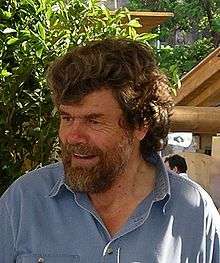
- 1971 – Journeys to the mountains of Persia, Nepal, New Guinea, Pakistan and East Africa;
- 1972 – Noshak (7,492 m) in the Hindu Kush;
- 1973 – Marmolada West Pillar, first climb; Furchetta West Face, first climb;
- 1974 – Aconcagua south wall (6,959 m), partially new "South Tyrol Route"; Eiger North Face with Peter Habeler in 10 hours (a record that stood for 34 years, for a roped party);
- 1976 – Mount McKinley (6,193 m), "Face of the Midnight Sun", first climb;
- 1978 – Kilimanjaro (5,895 m), "Breach Wall", first climb;
- 1979 – Ama Dablam rescue attempt; first climbs in the Hoggar Mountains, Africa;
- 1981 – Chamlang (7,317 m) Centre Summit-North Face, first climb;
- 1984 – Double-Traverse of Gasherbrum II and I with Hans Kammerlander;
- 1985 – Tibet Transversale with Kailash exploration;
- 1986 – Crossing of East Tibet; Mount Vinson (4,897 m, Antarctic), on 3 December 1986, thus becoming the first person to complete Seven Summits without the use of supplemental oxygen on Mount Everest;[16]
- 1987 – Bhutan trip; Pamir trip;
- 1988 – Yeti-Tibet solo expedition;
- 1989–1990 – Antarctic crossing (over the South Pole) on foot, 2,800-km trek with Arved Fuchs;
- 1991 – Bhutan crossing (east-west); "Around South Tyrol" as a positioning exercise, where he was peripherally involved in the Ötzi find, being among the groups who inspected the mummy on-site the day after its initial discovery;
- 1992 – Ascent of Chimborazo (6,310 m); crossing of Taklamakan Desert in Xinjiang
- 1993 – Trip to Dolpo, Mustang and Manang in Nepal; Greenland longitudinal crossing (diagonal) on foot, 2,200-km trek;
- 1994 – Cleaning project in North India/Gangotri, Shivling region (6,543 m); to Ruwenzori (5,119 m), Uganda;
- 1995 – Arctic crossing (Siberia to Canada) failed; trip to Belukha (4,506 m), Altai Mountains/Siberia;
- 1996 – Trip through East Tibet and to Kailash.
- 1997 – Trip to Kham (East Tibet); small expedition into Karakorum; filming on the Ol Doinyo Lengai (holy mountain of the Massai) in Tanzania
- 1998 – Trip to the Altai Mountains (Mongolia) and to Puna de Atacama (Andes)
- 1999 – Filming: San Francisco Peaks, Arizona (Holy mountain of Navajo); trip into the Thar Desert/India
- 2000 – Crossing of South Georgia on the Shackleton Route; Nanga Parbat Expedition; filming on Mount Fuji/Japan for the ZDF series Wohnungen der Götter (~"Homes of the Gods")
- 2001 – Dharamsala and foothills of the Himalayas/India; ZDF series Wohnungen der Götter on Gunung Agung/Bali
- 2002 – In the "International Year of the Mountains" visit by mountaineers into the Andes and ascent of Cotopaxi (5,897 m), Ecuador
- 2003 – Trekking to Mount Everest (fiftieth anniversary of the first successful climb); trip to Franz Joseph Land/Arctic; on 1 October opening of the "Günther Mountain School" in the Diamir Valley on Nanga Parbat/Pakistan
- 2004 – Longitudinal crossing of the Gobi Desert (Mongolia) on foot, about 2,000 km trek
- 2005 – Trip to the Dyva Nomads in Mongolia; "time journey" around Nanga Parbat/Pakistan
The Seven Summits
In 1985 Richard Bass first postulated and achieved the mountaineering challenge Seven Summits, climbing the highest peaks of each of the seven continents. Messner suggested another list (the Messner or Carstensz list) replacing Mount Kosciuszko with Indonesia's Puncak Jaya, or Carstensz Pyramid (4,884 m or 16,024 ft). From a mountaineering point of view the Messner list is the more challenging one. Climbing Carstensz Pyramid has the character of an expedition, whereas the ascent of Kosciuszko is an easy hike. In May 1986 Pat Morrow became the first person to complete the Messner list, followed by Messner himself when he summitted Mount Vinson in December 1986 to become the second.[16]
The Messner Mountain Museum
In 2003 Messner started work on a project for a mountaineering museum.[17] On 11 June 2006, the Messner Mountain Museum (MMM) opened, a museum that unites within one museum the stories of the growth and decline of mountains, culture in the Himalayan region and the history of South Tyrol.
The MMM consists of five locations:
- MMM Firmian at Sigmundskron Castle near Bozen is the centerpiece of the museum and concentrates on man's relationship with the mountains. Surrounded by peaks from the Schlern and the Texel range, the MMM Firmian provides visitors with a series of pathways, stairways, and towers with displays that focus on the geology of the mountains, the religious significance of mountains in the lives of people, and the history of mountaineering and alpine tourism. The so-called white tower is dedicated to the history of the village and the struggle for the independence of South Tyrol.[18]
- MMM Juval at Juval Castle in the Burggrafenamt in Vinschgau is dedicated to the "magic of the mountains", with an emphasis on mystical mountains, such as Mount Kailash or Ayers Rock and their religious significance. MMM Juval houses several art collections.[19]
- MMM Dolomites, known as the Museum in the Clouds, is located at Monte Rite (2181 m) between Pieve di Cadore and Cortina d'Ampezzo. Housed in an old fort, this museum is dedicated to the subject of rocks, particularly in the Dolomites, with exhibits focusing on the history of the formation of the Dolomites. The summit observation platform offers a 360° panorama of the surrounding Dolomites, with views toward Monte Schiara, Monte Agnèr, Monte Civetta, Marmolata, Monte Pelmo, Tofana di Rozes, Sorapis, Antelao, Marmarole.[20]
- MMM Ortles at Sulden on the Ortler is dedicated to the theme of ice. This underground structure is situated at 1900 metres and focuses on the history of mountaineering on ice and the great glaciers of the world. The museum contains the world's largest collection of paintings of the Ortler, as well as ice-climbing gear from two centuries.[21]
- MMM Ripa at Brunico Castle in South Tyrol is dedicated to the mountain peoples from Asia, Africa, South America and Europe, with emphasis on their cultures, religions, and tourism activities.[22]
- MMM Corones, opened in July 2015 on the top of the Kronplatz mountain (Plan de Corones in Italian), is dedicated to traditional climbing.[23]
Politics
Messner was elected an MEP for the Italian Green Party in 1999, serving until 2004.[24]
In media
- Gasherbrum – Der leuchtende Berg – A 1985 Werner Herzog TV documentary, also known as "The Dark Glow of the Mountains".
 At Juval Castle, 1994
At Juval Castle, 1994 - Nanga Parbat – A 2010 film based on Messner's achievements.
- The Unauthorized Biography of Reinhold Messner – A 1999 album coincidentally sharing its name with Messner, but not named after him, released by Ben Folds Five.
See also
References
- ↑ Extrem Europa, Live, Vienna, No. 3 (01/02/2008), p. 16.
- 1 2 Alexander, Caroline (November 2006). "Murdering the Impossible". National Geographic.
- ↑ Rhoads, Christopher (11 December 2003). "The controversy surrounding Reinhold Messner". The Wall Street Journal. Retrieved 7 February 2008.
- ↑ Connolly, Kate (19 January 2010). "Nanga Parbat film restarts row over Messner brothers' fatal climb". The Guardian. London. Retrieved 22 May 2010.
- 1 2 Krakauer 153
- ↑ Krakauer 61
- ↑ "Reinhold Messner - Home". Reinhold-messner.de. Retrieved 2016-09-20.
- ↑ Messner, Reinhold (1979). Aufbruch ins Abenteuer. Der berühmteste Alpinist der Welt erzählt. Bergisch Gladbach, p. 122 – 133.
- ↑ "Nanga Parbat Body Ends Messner Controversy". Outdoors Magic. 19 August 2005. Retrieved 14 March 2014.
- 1 2 Connolly, Kate (19 January 2010). "Nanga Parbat film restarts row over Messner brothers' fatal climb". The Guardian. Retrieved 14 March 2014.
- 1 2 3 4 5 6 7 8 9 10 11 12 13 14 Messner, Reinhold (2002). Überlebt – Alle 14 Achttausender mit Chronik BLV, Munich.
- ↑ Messner, Reinhold/Gogna, Alessandro: K2 – Berg der Berge. BLV, Munich 1980.
- 1 2 Messner, Reinhold: Alle meine Gipfel. Herbig, Munich 1983.
- ↑ Entry in AAJ Online
- ↑ Kammerlander, Hans: Bergsüchtig. Piper, Munich 2001, 6th ed. (p.81ff)
- 1 2 History of 7 Summits project — who was first?
- ↑ Thomas Kunze: Messners 15. Achttausender, Berliner Zeitung, 8 July 2006
- ↑ "MMM Firmian". Messner Mountain Museum. Retrieved 9 February 2014.
- ↑ "MMM Juval". Messner Mountain Museum. Retrieved 9 February 2014.
- ↑ "MMM Dolomites". Messner Mountain Museum. Retrieved 9 February 2014.
- ↑ "MMM Ortles". Messner Mountain Museum. Retrieved 9 February 2014.
- ↑ "MMM Ripa". Messner Mountain Museum. Retrieved 9 February 2014.
- ↑ Federica Lusiardi. "Zaha Hadid's MMM Corones museum gazes at the mountains". Inexhibit. Retrieved November 25, 2015.
- ↑ "Search for a Member; European Parliament". Europarl.europa.eu. Retrieved 2016-09-20.
Selected bibliography (English translations)
- Messner, Reinhold (1998). Free Spirit: A Climber's Life. Seattle, WA, USA: Mountaineers Books. ISBN 0-89886-573-5.
- Messner, Reinhold (1998). The Crystal Horizon: Everest – The First Solo Ascent. Seattle, WA, USA: Mountaineers Books. ISBN 0-89886-574-3.
- Messner, Reinhold (1999). All Fourteen 8,000ers. Seattle, WA, USA: Mountaineers Books. ISBN 0-89886-660-X.
- Messner, Reinhold (2000). My Quest for the Yeti: Confronting the Himalayas' Deepest Mystery. New York, NY, USA: St. Martin's Press. ISBN 978-0-312-20394-8.
- Messner, Reinhold (2001). The Big Walls: From the North Face of the Eiger to the South Face of Dhaulagiri. Seattle, WA, USA: Mountaineers Books. ISBN 0-89886-844-0.
- Messner, Reinhold; trans. by Tim Carruthers (2002). The Second Death of George Mallory: The Enigma and Spirit of Mount Everest. New York, NY, USA: St. Martin's Griffin. ISBN 0-312-27075-5.
- Messner, Reinhold (2003). The Naked Mountain. Seattle, WA, USA: Mountaineers Books. ISBN 0-89886-959-5.
- Publications in German
Sources
- Wetzler, Brad (October 2002). "Reinhold Don't Care What You Think". Outside Magazine.
- Krakauer, Jon. Into Thin Air. United States of America: Random House, 1800.
Further reading
- Messner, Reinhold (October 1981). "I Climbed Everest Alone... At My Limit". National Geographic. Vol. 160 no. 4. pp. 552–566. ISSN 0027-9358. OCLC 643483454.
External links
| Wikimedia Commons has media related to Reinhold Messner. |
- Official site (German)
- Discovery of remains ends controversy about the death of Reinhold Messner's brother
- Messner Mountain Museum website
- Messner – 2002
- (rare English interview with Messner) on YouTube
- Portrait Painting of active Messner
Interviews
- Gaia Symphony Documentary series (Japanese production).
